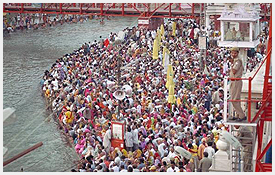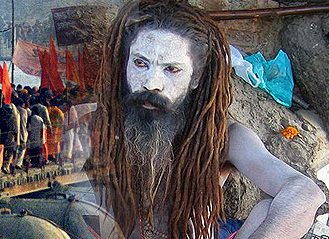» About Haridwar
» About Rishikesh
» About Ujjain
» About Nashik
» About Allahabad
» About Ganga
» About Akharas
» About Ayurveda
» About Yoga
» About Festivals
»About Kumbh Mela
» Ardh Kumbh
» Haridwar Information
» Haridwar Tourist Information
» Ayurveda Tours
» Chandrashilla Sumit Trekking
» Dehradun Mussoorie
» Dodi Tal Trekking
» Gangotri Trek Tour
» Golden Triangle Tour
» Har Ki Dun Trek
» Haridwar Rishikesh Jaipur Tour
» Chardham Pilgrimage
» Kumbh Itinerary Detail
» Footstep Lord Buddha
» Jain Yatra Kutchh
» Kailash Darshan By Foot
» Kailash Darshan By Helicopter
» Lhasa Kailash Mansarovar Yatra
» Muktinath Darshan Yatra

Home - About Kumbh Mela
About Kumbh Mela
The culture of India is one of the oldest cultures in the world. India’s one billion people have descended from a variety of races. This has resulted in a VIBGYOR of fairs and festivals being celebrated throughout the year.
descended from a variety of races. This has resulted in a VIBGYOR of fairs and festivals being celebrated throughout the year.Kumbh Mela is pilgrimage of Hindus. It occurs once in twelve years at four different locations- Prayag in southern part of Uttar Pradesh, Haridwar-a holy city in Uttarakhand, Ujjain in the Malwa region of Madhya Pradesh and Nasik in Maharashtra. Mela at Prayag is termed as Maha kumbh Mela as it is the largest pilgrimage gathering in the world which collects million people on a single day. Kumbh means pitcher. The origin of Kumbh Mela is based upon the following story: Many years ago, perhaps in the Vedic time, gods and demons made a tentative agreement to work together in obtaining amrita, the nectar of immortality from the Milky Ocean, and to share this equally. However, when the Kumbh, the pot, containing the amrita appeared, the demons ran away with the pot and the gods chased them. For twelve days and twelve nights, equal to twelve human years, the gods and demons fought in the sky to get this pot of amrita. It is believed that during the battle, drops of amrita fell on to four places: Prayag, Haridwar, Ujjain and Nasik. That is why it is celebrated in these four places.
The 'Kumbh Mela' takes place when the planet Jupiter enters Aquarius and the Sun enters Aries as believed by astrologers. It is the zodiac sign of Aquarius- a pitcher. India is a land of festivals and celebrations. These festivals give an opportunity for the people to come together and share in each other's joys. The devotees gather at these four places from different parts of the country and take bath at the bank of rivers, holy bath or Maha Sanan at the bank of Sangam. Sangam is union of three rivers- tha Ganga, the Yamuna and the Saraswati. When the Ganga and the Yamuna meets, the Saraswati is invisible but it is believed that water of Saraswati finally meets these two rivers at their base. Sadhus wearing saffron sheets, Nanga Sanyasis or Digambars wearing nothing in chilly winters attend the mela. They sing devotional songs. Due to the strong faith and devotion by million of Indians, the mela is getting attention in other parts of the world too. It has got international tag of “the world’s most massive act of faith”. Hiuen Tsiang of china was first foreigner to mention khumb mela in his diary.
This is believed that by taking bath in the holy river, one can wipe out all the sins of his/her life. The Mela is basically a bathing ritual. They face many discomforts while attending this mela as they sleep in open in extreme cold weather on the chilly ground. After attending it, devotees lead to simple life to stay free from the moh maya and achieve liberation, an ultimate goal of ones life.
In the several last years, uncountable devotees visited these sacred places and experienced wonderful arrangements and discipline. In the sixth year of the series, ardh kumbh mela is held. Magh mela or mini kumbh is celebrated annually on the banks of the Sangam. The major Kumbh parva or bathing day is the day of Mauni Amavasya, while other significant bathing days are paush Poornima, Makar Sankranti, Vasant panchami Maghi poornima and Maha Shivratri.
Forth coming kumbh mela-
Haridwar (Purna Kumbha mela) in the year 2010 (March-April)
Prayag (Purna Kumbha Mela) in the year 2013 (January 27-February 25)
Nasik (Ardh Kumbha Mela) in 2015 (August 15 to September 13)
Ujjain (Ardh Kumbh Mela) in 2016 (April 22 to May 21)




